
Fleet (later Training) Aircraft Carrier
WW1/WW2 RN Aircraft Carriers:
ww1 seaplane carriers | Ark royal (1914) | Campania | Furious | Argus | Hermes | Eagle | Courageous class | Ark Royal (1936) | Illustrious class | Implacable class | Colossus class | Majestic class | Centaur class | Unicorn | Audacity | Archer | Avenger class | Attacker class | HMS Activity | HMS Pretoria Castle | Ameer class | Merchant Aircraft Carriers | Vindex classForty years of career and two wars
To the exception of HMS Furious, converted in 1917 and operational sooner, HMS Argus was also a veteran of two wars with 20 years of active service, the longest among British Aircraft Carriers. But to the difference of HMS Furious, she was never rebuilt, just modernized. What really setup her apart is the fact she became the first example of the standard pattern of an aircraft carrier: Full-length flight deck for taking off and landing unempeded. Several years were needed however from September 1918 to reach the optimum design and Argus pioneered types of arresting gear and aircraft operations as well as early combined fleet tactics.
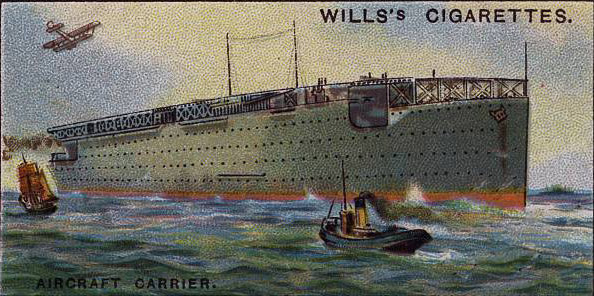
Argus depicted in a Will’s cigarettes box, interwar.
Top-heavy originally, modifications were done in the mid-1920s to cure her stability issues, and after some time in the China Station she was reserve as the result of budget reductions, only resurrected and mobilized when WW2 broke out. Partially modernised she served as a training ship, qualifying pilots in deck-landings, until June 1940. The she carried out the first of many many ferry trips in the Western Mediterranean, to the soon beleaguered Malta.

hms argus 1918 profile
Later she also taxied lend-lease aircraft Murmansk, Russia and also Takoradi on the African Gold Coast, or Reykjavík in Iceland. In 1942 she on the front-line again and by June, she participated in Operation Harpoon, covering a convoy. In November 1942 she took part in Operation Torch, damaged by a bomb. Afterwards more carriers were commissioned and she resumed deck-landing practice home, to late September 1944, an accommodation by December until after WW2, discarded and sold in 1946. A rather long career despite of her initial beginnings.
The construction of Conte Rosso and requisition
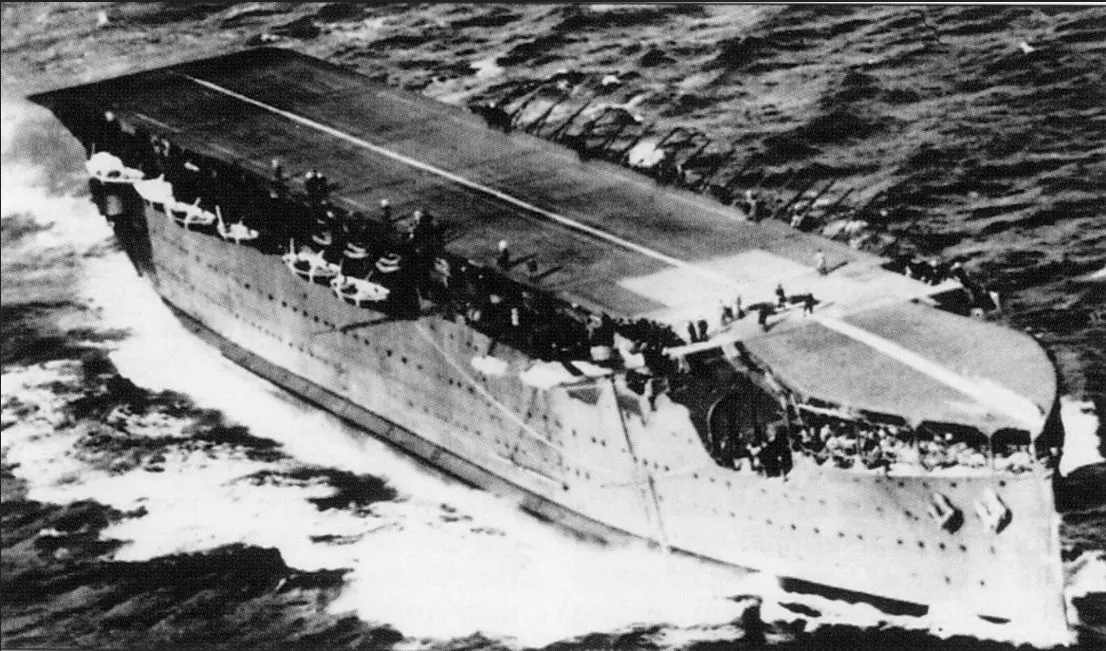
How an Italian liner became the world’s first modern aircraft carrier ?
In 1912 already William Beardmore proposed to the Admiralty an aircraft carrier design sporting a full-length flight deck, precisely after what happened to the US. The RN however at the time saw no practical applications and declined the offer. The idea came from James Graham, 6th Duke of Montrose and director of the company, which had its entries in the Navy, which proposed a “A Parent Ship for Naval Aeroplanes and Torpedo Boat Destroyer”.
It had two islands with the flight deck running between them, silthuing which was also envisioned later for the Eagle and latter abandoned. Each island also comprised a funnel each and a large net was to stop out of control planes, in between. They were also connected by bracing, allowing the bridge to be mounted on top, with 20 feet (6.1 m) to spare above the for the aircraft.
-Construction of the Italian ocean liners Conte Rosso and Giulio Cesare was suspended by order in William Beardmore and Co. in August 1914. This was the second one, built in Scotland in the 1920s, also active in WW2 (sunk by HMS Upholder). But the original Conte Rosso and G. Cesare were ordered by Lloyd Sabaudo of Genova in 1913. Construction indeed had just started in 1914. They were rather large at 14,000 tonnes standard, long, at 172 m or 565 feets overall, and reasonably fast with 20,000 shp for 20 knots. We will not dweve more of the Conte Rosso class since ionformation is scarce on the matter and mostly deduced from the later conversion.
Specifications and requisition
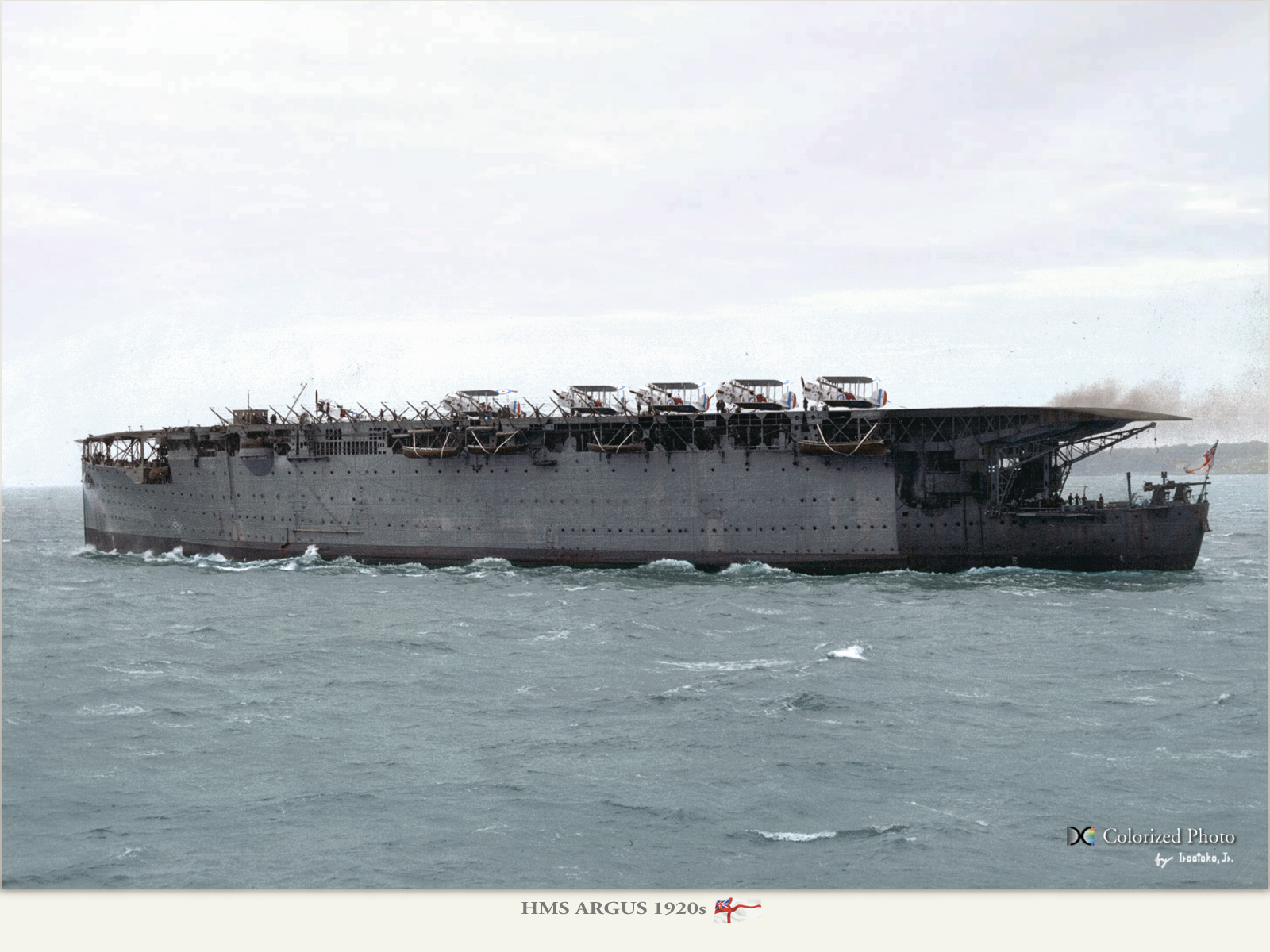
HMS Argus in the 1920s, after refit, colorized by Irootoko Jr. She shows five Fairey IIIC aligned on deck. Her stern was painted black not as an experimental camouflage but to protect the hull from the smoke. It was still there in WW2.
In 1915, the RN admiralty already had some experience in seaplane carriers, notably in the Dardanelles, and recoignised the limitations of these operationally. Soon, it was alleged that wheeled models were far better and so since it was proven in 1911 that both taking off and landing on platforms (Eugen Ely) was practicable, various tests were made with small platforms.
However with early war experience, the Admiralty returned to Beardmore’s proposal and so the design was just dusted off while a team was tasked to find two suitable hull meetinf several criters of size, speed and readiness for conversion. They did not have top search long, when contacted Beardmore. There were just fast hulls in its yard perfectly suitable. And so that’s how the Admiralty got interested into the Conte Rosso class. Not only they had the perfect hulls available, but also the yars which proposed the design in the first place.
The two vessels were purchased by the RN on 20 September 1916, two years after requisition, and with little work done. Indeed, by that time, the bottom of her hull was completed, as well as the machinery in place, although still lacking many fittings to be operational, not least the exhausts. Whereas it was just started on Giulio Cesare, so Beardmore was asked to complete her and drop the other completely to focus work on completing the first, pending her future name. She was given the Pennant number I49, and later after some litterate internal classic debate about her intended role, received the name of Argus Panoptes, the many-eye giant of greek mythology. Indeed at the time, aircraft were tasked of reconnaissance first and foremost. She was to be the eye of the fleet.
Conversion Design in detail
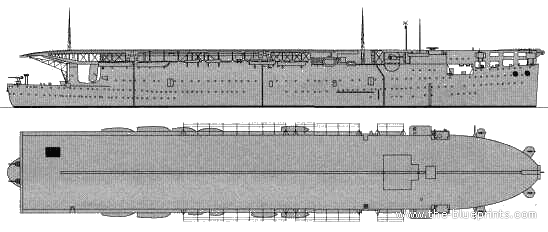
2 views of the final design, pilot house retracted.
The original hull was kept as is, but with some gutted compartment allowing to stire ammunitions and aviation gasoline as well as a workship. The hangar, which b itself was revolutionary, was running all along the ship and built just above the deck. For stability it was low, but the average 1914 planes easily fit inside. The original plan was modified: It was decided to relocate the funnels elsewhere to avoid smoke interference and turbulence on deck. They were indeed ducted ducted aft, between the roof of the hangar deck and flight deck, enclosed by a casing in which cooler air was driven by electric fans. Somke was pouring from underneath the aft end of the flight deck but there were extra ventilation openings on the rear side of the hull, propelled out by two more large electric fans.
The ship was not very large, but again, planes of the time was rather small. The other original idea of two islands (later resurrected for HMS Eagle) was abandoned. Indeed, by November 1916 just a month after she was acquired, studied were led in a wind tunnel at the National Physical Laboratory, to evaluate turbulence caused by the twin islands and bridge. Some issues were located, but the plan was not charged until the ship was close to completion.
They were never built: In April 1918 indeed, order came to not include them and make a flush-deck configuration. The decision did not came of the blue but had its origin after the HMS Furious trials,
showing real life serious turbulence issues. In the end, the ship still needed a bridge somewhat and a small, compact and minimalistic one was mounted in a location underneath the flight deck, retractable,
used as pilot house. The full bridge in fact extending from side to side forward of the hangar, providing at least some view forward, but fiarly limited by the flight deck lip above. The pilot house was
located in the middle of the flight deck and retracted for flight operations. It proved a sound concept at the time, and it was to be reused later. In total after conversion she carried some 495 officers and men.
Hull construction
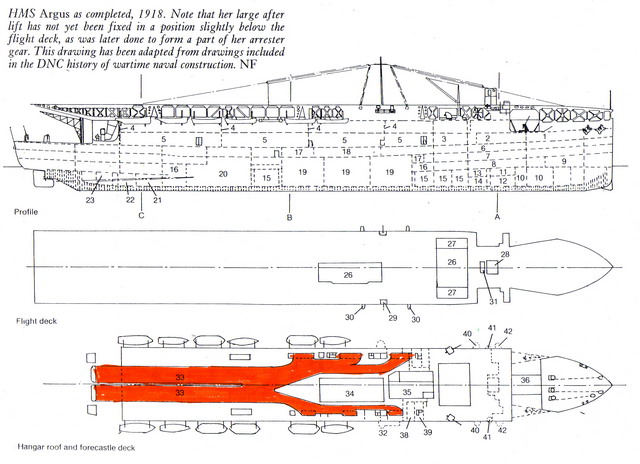
Internal compartimentation and exhausts truncation
Conte Rosso/HMS Argus hull was 565 feet (172.2 m) in lenght overall, and 68 feet (20.7 m) wide, for 23 feet 3 inches (7.1 m) draught deeply loaded. Displacement, normal, was 14,450 long tons (14,680 t) when completed as a carrier, 15,575 long tons (15,825 t) fully loaded. This was a bit short but at the time a deck that long was unique and allowed smooth air operations, even without arresting cables or catapults.
USS Argus inherited however from a liner which was design with its own stability rolerances, calculated from the amount of superstructures. With a hangar on top of these of course, the metacentric height was brand new and needed adjustments. Stability was a main concerns right from the start, and to combat added topside weight, they started to add 600 long tons (610 t) of ballast. After this however she still had a low metacentric height of 1.6 feet (0.49 m) lightly loaded, but jumping to 3.8 feet (1.2 m) deeply loaded. She was very steady but heeled a lot when turning hard, but stays agile at medium and high speeds. It was however not at low speeds and the wind had an effect due to her height.
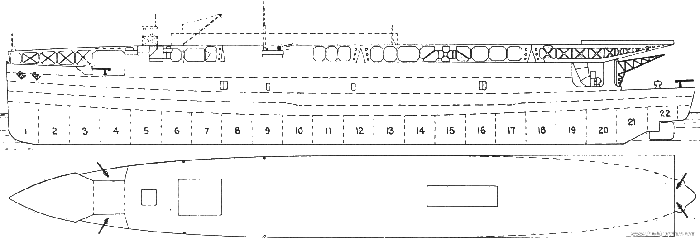
Initial design and compartimenation
Protection was fairly limited: The rear magazine and torpedo warhead storage magazine were in a “box” plated with 2 inches (51 mm) walls, on all sides. On the forward magazine and bomb storage it was the armored deck itself which protected them, also of 2-inch. Any destroyers could have punched through but at the time it was agreed she would be escorted by at least two destroyers and/or a light cruiser. Her defensive armament was also light.
It should be noted however that her hangar was made fire proof by the adoption of three fire curtains which divided the hangar into three sections, followed by another which separated the hangar itself from the quarterdeck. When deployed across they could stop a fire from spreading. This innovation too, was called by all other designs to follow. But it was realized at the time avgas could be a hazardous compound which was to be stopped for spreading.
The launch of HMS Argus was realized on 2 December 1917, but her completion would take almost one full year, slowed by labour shortages. Therefore when completed and commissioned on 16 September 1918, her active service was delayed by initial training.
Powerplant
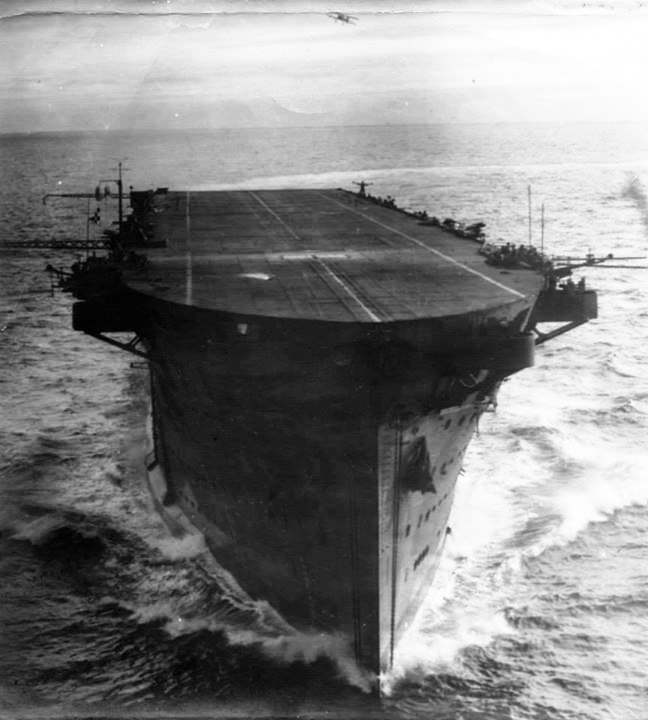
HMS Argus bow, full speed
The original liners were built for speed, but in a less stringent way than for military vessels. They had four sets of Parsons geared steam turbines, driving one propeller shaft each, with inner and outer shafts. Steam came from 12 cylindrical Scotch boilers. Total output was 20,000 shaft horsepower (15,000 kW) but in trials, they could be pushed to produced 21,376 shaft horsepower (15,940 kW) resulting in a lightly better speed of 20.506 knots (37.977 km/h; 23.598 mph) than the 20 planned. For autonomy she carried 2,500 long tons (2,500 t) of fuel oil, enough for a limited 3,600 nautical miles (6,700 km; 4,100 mi) at 10 knots (19 km/h; 12 mph).
Armament
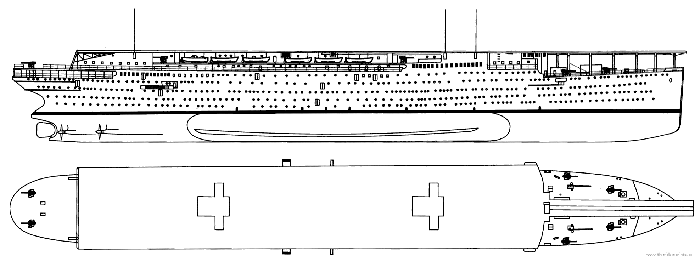
Upgraded design after deletion of the islands, and catapult (never installed)
HMS Argus was given a light armament but very innovative at the time: She had six 4-in (102 mm) guns. Of these, only two were for surface combat, with low-angle mountings, in sponsons. The other four were located also on sponsons, but in the corners. Two on the aft deck for greater arc of fire, on high angle AA mounts and two on the intermediate deck forward. For the first time also, a carrier was designed with more AA firepower than surface firepower.
This was seen as rather weak later and during upgrades, the armament was boosted, located mostly on the forward deck, well enumcumbered by having the forward flight deck replaced by a single, narrow small launch catapult deck in 1938. On either side were located thre duel purpose guns. This was later modified again, and she regained a full flight deck, which eliminated the forward deck guns, replaced by light AA guns: In 1940, she indeed had two QF Mk V 4-in AA guns, shielded, on her quarterdeck, and three quadruple Vickers .50 HMGs on each side of her hull and a third centreline of the quarterdeck. This still was weak, and in 1942, the .5 cal. Vickers were replaced by 13 single Oerlikon 20 mm light AA guns. Duez to stablility issues and lack of space, this stays the same until her retirement in 1944.
Facilities
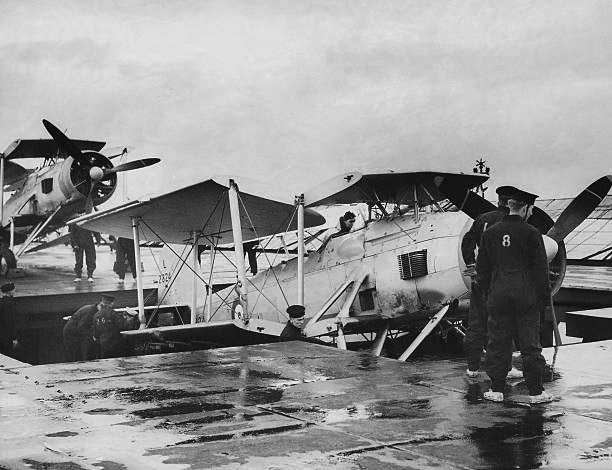
A Swordfish is lifted from the aft cross-shaped elevator
HMS Argus’s flight deck measured 549 feet (167.3 m) long overall, so shorter than the hull. The forward lip arrived just at the bow, but the landing section aft was shy of around ten meters (30 ft) aft of the stern.
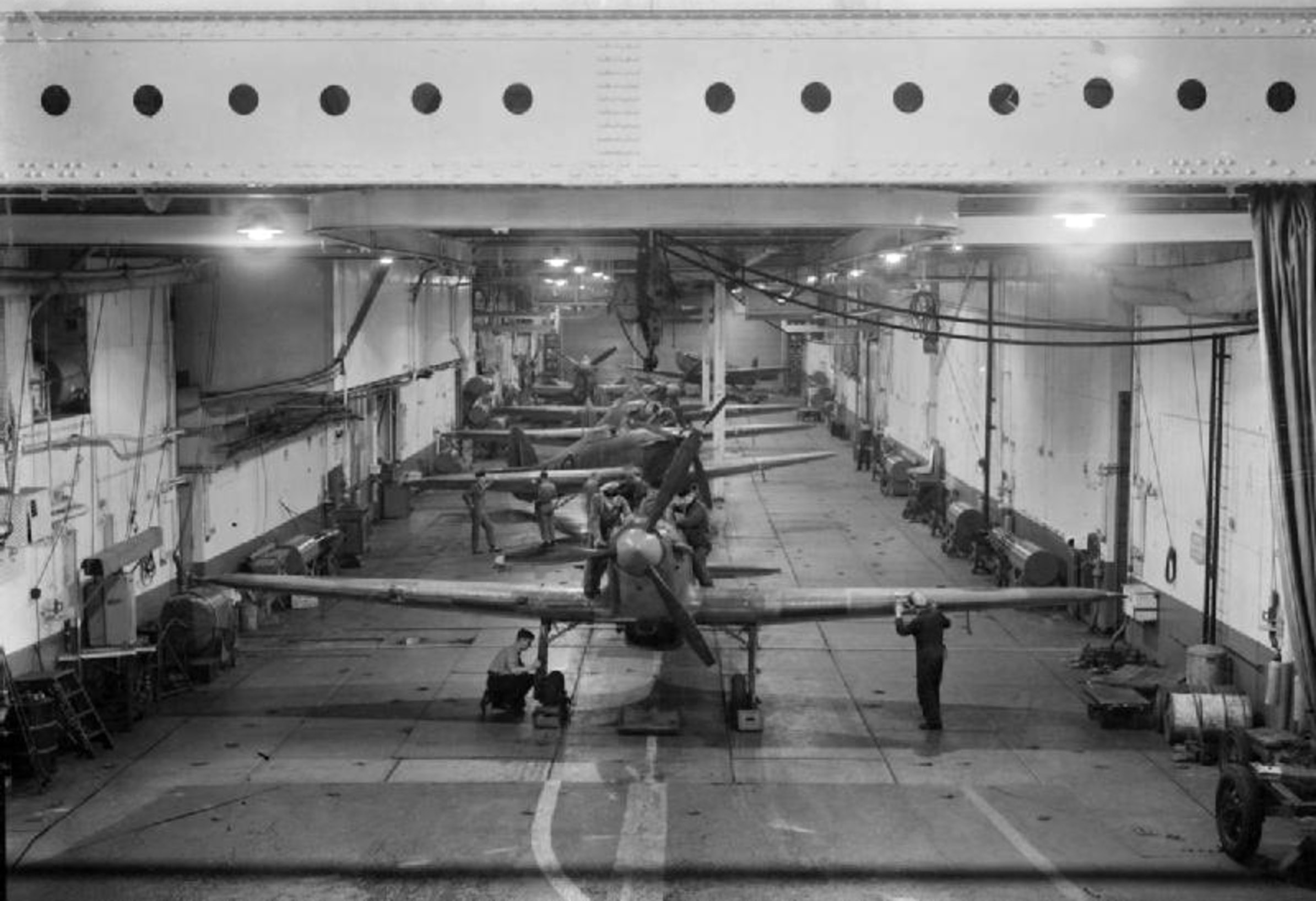
Hangar in 1942
The hangar below measured just 330 feet (100.6 m) in lenght, and was 48–68 feet (14.6–20.7 m) in width. This left some room to the 1914 planes to maneouver, but was woelly unsufficient in 1940. Modern models barely fit inside, in a straight line. The hangar though was 16 feet (4.9 m) high, also just sufficient for some models. Two aircraft lifts were installed, fore and aft, with unequal size: The forward one was 30 x 36 feet (9.1 m × 11.0 m), the aft one 60 x 18 feet (18.3 m × 5.5 m), reclangular. The latter was usable by folded or none wings models, a first also for British carriers at the time.
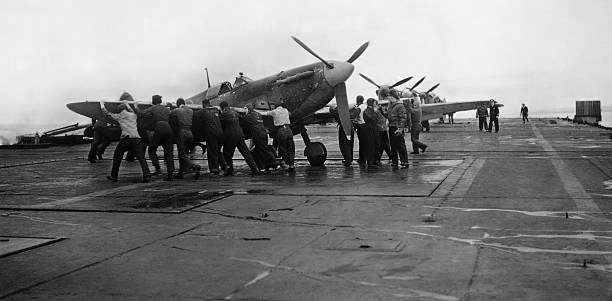 Seafire pulled out from the reshaped aft elevator in 1942
Seafire pulled out from the reshaped aft elevator in 1942
Both the tall hangar ceiling (which also the suspension or spare wings and fuselages for example) and generous lifts were an added advantage to the design. Thanks to this she could carry 18 aircraft of the smaller model, down to 15 for more balanced types. There was no arresting cabling interated into her first design. It was assumed the deck would be cleared to allow planes to used the full lengt to go to a full stop using their breaks. Of course the rapid rise in weight and speed was not taken in account and proper arresting gear was installed during her first refit in the 1920s.
Two large cranes were positioned on the quarterdeck aft of the flight deck to recover crashe dplane sor floatplanes. Petrol storage at the time was limited to 8,000 imperial gallons (36,000 l; 9,600 US gal) not in tanks, but in 2-imperial-gallon (9.1 l; 2.4 US gal) tins, all stowed below the waterline. To refued the planes, workload was awaited but this heavy compartimentation was seen as an additional safety compared to a traditional gasoline tank and pipes/pumps system. Of course, yet again, with larger models, which needed far more fuel this system was changed to traditional tanks and piping.
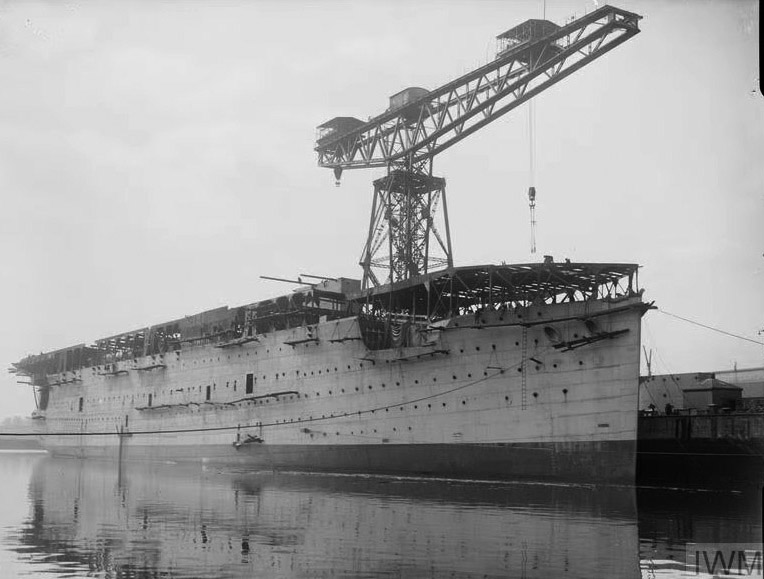
As completed
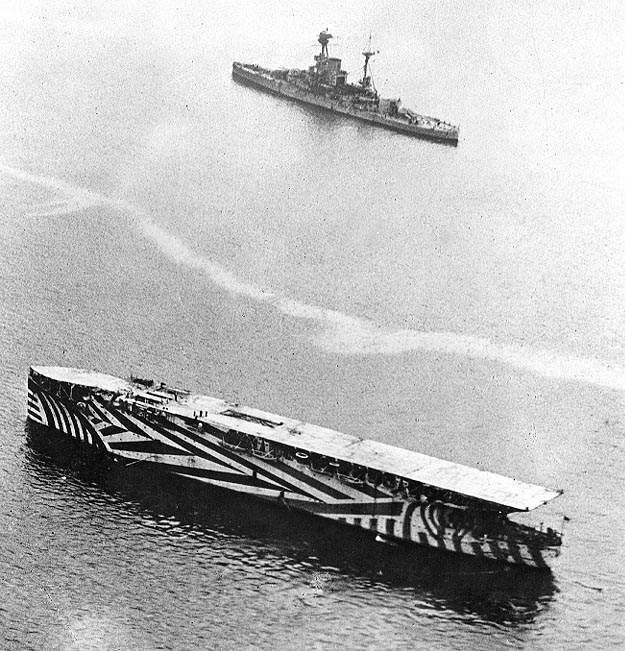
In harbor, 1918

Camouflaged in 1918, underway
Air group of HMS Argus
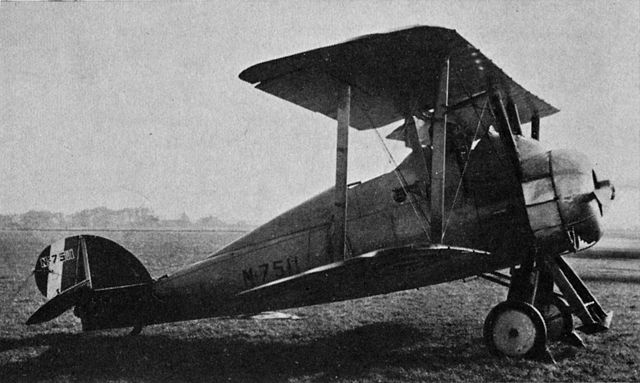
The “hunchback”, ungainly Parnall Panther, which flew in 1917 and was still operational in 1926.
Air group wise, HMS Argus had the chance of carrying an extremely large variety of planes, at least which could fit inside the hangar for her permanent 15 planes park. Many could be parked on the flight deck, and she taxied land-based models at several occasions:
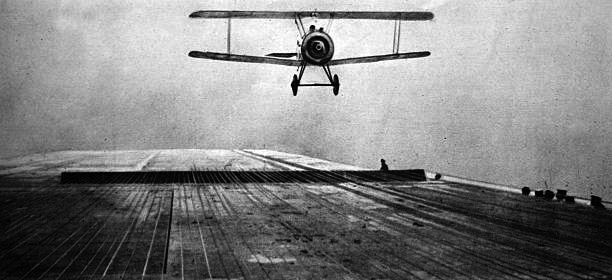
sopwith Camel landing in 1918
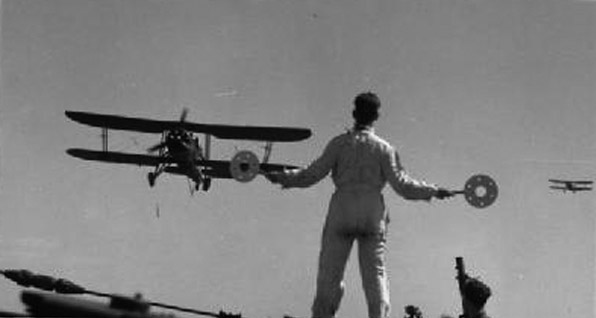
Swordfish appraching HMS Argus WWII IWM
According to navypedia, she carried in 1920 four sopwith Camel fighters (not navalized), eight 11/2 Navy Strutter (also), two Supermarine Walrus I and two Fairey IIIA, so 16 in all. In 1921 she carried ten Parnall Panther reconnaissance planes and three Fairey IIIC torpedo planes, so 13 in all. Other sources states that she had two Airco DH.9A bombers and no Walruses in 1920. In 1922 she had Gloster Nightjar fighters aboard for tests and later permanent and alternative to Fairey Flycatchers. Parnall Spotters were later replaced by Avro Bisons.
This changed during the interwar but records are difficult to pinpoint. In 1938 when decommissioned she only had Fairey Swordfish aboard, fourteen in all. This varied in 1940 (three) and 1941 (twelve) as she was used for ferrying aircraft, included in the hangar, hence no proper park until May 1941, where she carried three Fairey Fulmar. In August they were replaced by two Grumman Martlet I for her CAP.
At last in November 1941 when she started to act in full operational readiness for convoy escort, she had a more balanced, larger air group, comprising four Fulmar and two Hawker Sea Hurricane for her CAP, and four Swordfish for reconnaissance and attack. In January 1942, the two Sea Hurricane were removed and in October 1942 she air group was boosted to eighteen Supermarine Seafire IIC, also for escort duties, but this time for Murmansk, with an icreased air attack risk by the Luftwaffe. This was her last known air park. Afterwards in home waters she was used for training and had none.
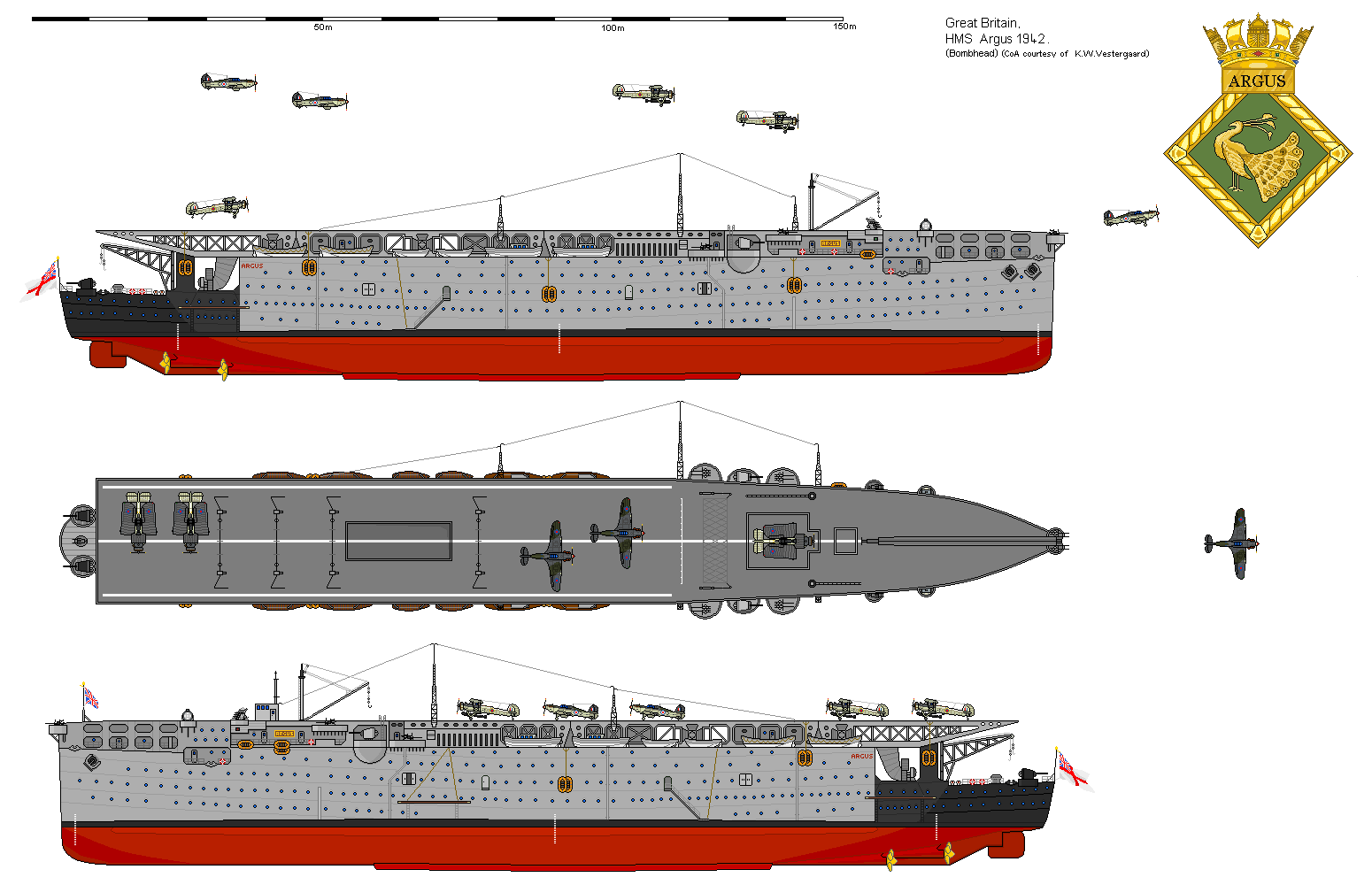
On shipbucket

1918 camouflage, blueprints
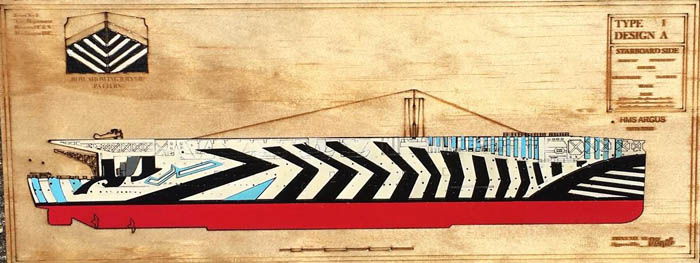
Dazzle design for HMS Argus, 1918
⚙ HMS Argus specifications |
|
| Dimensions | 565 x 68 ft x 23 ft 3 in (172.2 x 20.7 x 7.1 m) |
| Displacement | 14,450 long tons standard, 15,775 long tons DL |
| Crew | 495 |
| Propulsion | 4 shaft Parsons Turbines, 12 cyl. Scotch boilers, 20.000 shp |
| Speed | 20 knots top speed |
| Range | 3,600 nmi@ 10 knots (6,700 km; 4,100 mi) |
| Protection | 2 in (51 mm) armor deck, boxes ammo/steering |
| Armament | 6x 4-in (102 mm) 1918, 18 planes, see notes |
Read More/Src
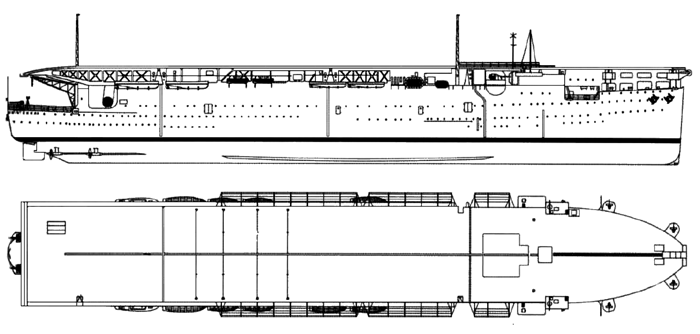
BP Argus 1942
wiki
destinationsjourney.com
historyofwar.org
www.navypedia.org (archived)
uboat.net
forum.worldofwarships.eu
carrierbuilders.net
maritimequest.com
fleetairarmarchive.net archive
Popsci
video: Footage British Movietone
video: Mil world channel
video: alfonso topp channel
Gardiner, Robert. Conway’s All the World’s Fighting Ships 1906–1921
Gardiner, Robert. Conway’s All the World’s Fighting Ships 1922–1947
Brown, David K. (2003) [1999]. The Grand Fleet: Warship Design and Development 1906–1922. Caxton Editions.
Brown, J. D. (2009). Carrier Operations in World War II. Annapolis NIS
Colledge, J. J.; Warlow, Ben (2006) [1969]. Ships of the Royal Navy: Complete Record of all Fighting Ships, Chatham Publishing.
Friedman, Norman (1988). British Carrier Aviation: The Evolution of the Ships and Their Aircraft. Annapolis NIS
Graham, James (Lord Montrose) (1952). My Ditty Box. London: Cape.
Halley, Jim (June–August 1992). “Early Days on Argus”. Air Enthusiast. No. 46.
Hobbs, David (2009). A Century of Carrier Aviation: The Evolution of Ships and Shipborne Aircraft. Seaforth Publishing.
Lenton, H. T. (1998). British & Empire Warships of the Second World War. Annapolis NIS
MacKay, Charles E. (2017). HMS Argus 1914 to 1947: The World’s First Flat-top Aircraft Carrier. A. MacKay
McBride, Keith (1994). “The ‘Hatbox’: HMS Argus”. In Roberts, John (ed.). Warship 1994. Annapolis NIS
McCart, Neil (2001). HMS Hermes 1923 & 1959. Fan Publications.
Rohwer, Jürgen (2005). Chronology of the War at Sea 1939–1945: The Naval History of World War Two. Annapolis NIS
Shores, Christopher; Cull, Brian; Malizia, Nicola (1987). Malta: The Hurricane Years: 1940–41.
Shores, Christopher; Cull, Brian; Malizia, Nicola (1991). Malta: The Spitfire Year: 1942.
Silverstone, Paul H. (1984). Directory of the World’s Capital Ships. Hippocrene Books.
Sturtivant, Ray (1984). The Squadrons of the Fleet Air Arm. Tonbridge, UK: Air-Britain (Historians).
Model kits
Hurricane Mk.I trop hms argus
FAA planes associated with HMS Argus
There is also a Shapeways 3-d printed 1/700 HMS Argus and a metal kit to 1/1250 scale produced in the 1980s by UK maker Oceanic and a Premier model hms argus 1918 painted and mounted.
Wartime service
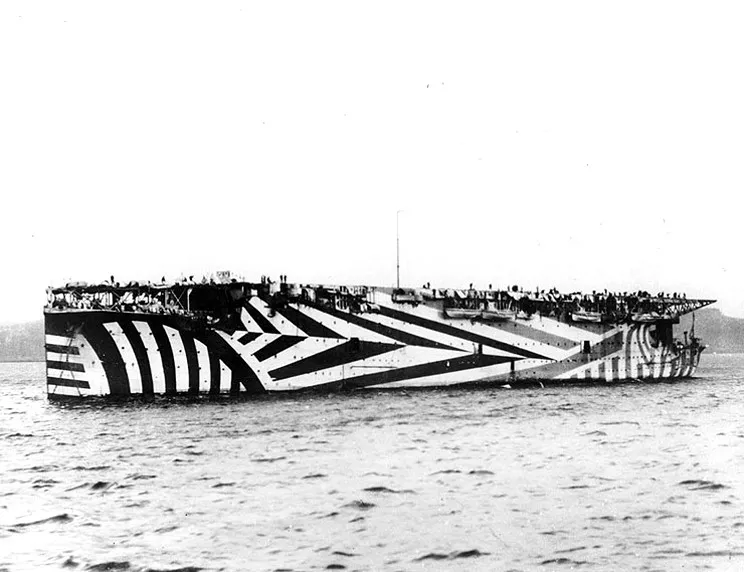
Argus 1918
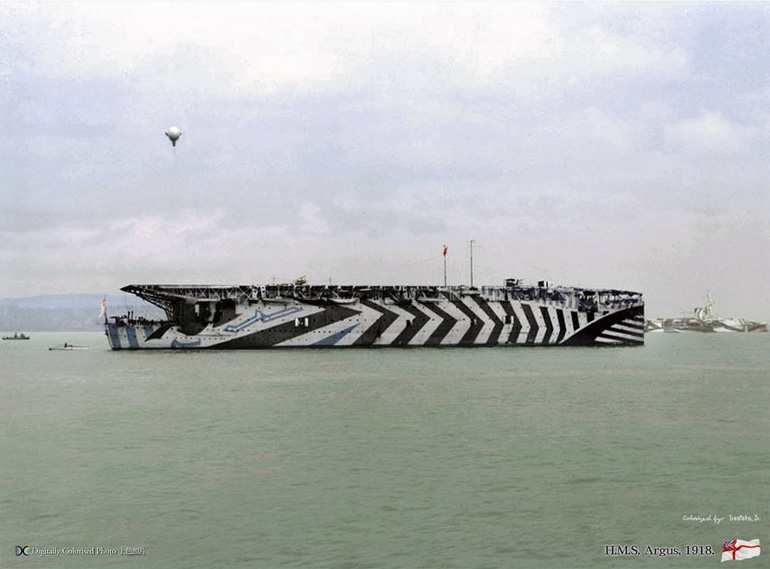 HMS Argus with her dazzle camouflage in November 1918
HMS Argus with her dazzle camouflage in November 1918
A very short WWI career
HMS Argus was commissioned on 16 September 1918, late in the war, and before any action she was tasked to conduct deck-landing trials. She tested the same longitudinal arresting gear already used on HMS Furious and transferred. The tests started on 24 September, with two Sopwith Ship Strutter from the Turnhouse Grand Fleet’s airbase. She also tested the effects of an island superstructure interference with flying operations in real life: This was performed by using a canvas-and-wood dummy island with a smoke box simulating funnel gases. Unfortunately no photos survived of these tests.
By 19 December, the war was over (although this was still chaos in the east a,nd a civil war developed in Russia), and she went on with her trials. HMS Argus saw 36 successful landings using Ship Strutters and Sopwith Pups.

In the Firth of Forth, 1918
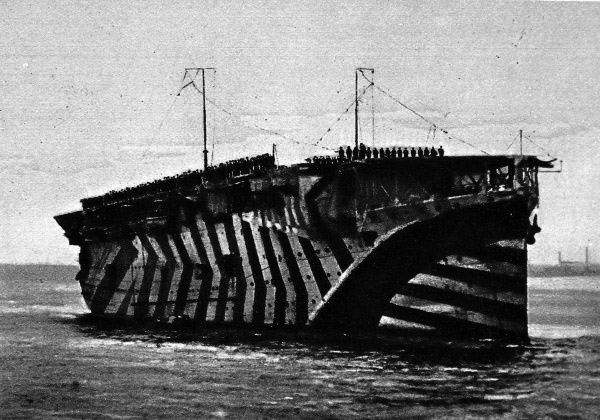
The interwar and refits

Underway in the 1920s
She had her first refit on 23 December, until 21 March 1919: Final, fixed arresting gear was installed, with wires lifted off to engage hooks on the undercarriages. The problem was the flight deck was now unusable for taking off. The aft lift was also lowered 9 inches (229 mm) to make the area suable when the lift was raised flush. A new serie of trials from April saw thelift widened in October 1919. At last she was considered serviceable to be assigned to the Atlantic Fleet, in January 1920. She took part in the fleet Spring Cruise, with just eight Ship Strutters aboard as recce models, and four Sopwith Camel fighters as well as two Airco DH.9A bombers for attack and two multirole Fairey IIIA floatplanes. Three planes missed the cables during their landings and were blown over the side, but these were the only incidents, recalling the pilots to absolutely snatch a cable when landing.
Back from the atlantic cruise, the staff and engineers made a reunion aboard HMS Argus on 19 May, discussing revised landing arrangements. It was considered that more wires were needed to give better chances to the pilots (and expecting heavier, faster-landing models). The landing well system was abandoned for ramps raised and lowered and powered palisades acting as crash barriers. They were placed on the side of the flight deck to retain aircraft that would fail to engage a wire.
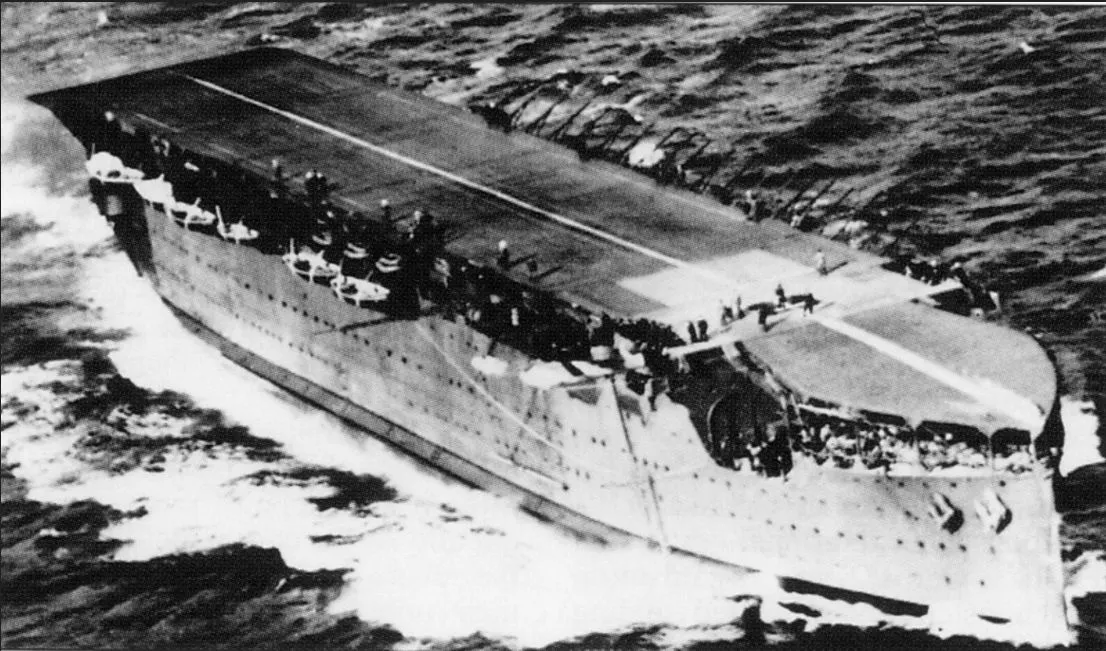
This revised system was tested first aboard HMS Eagle later that year. HMS Argus was modified in 1921 and was ready to take part in the Spring Cruise with this time ten Parnall Panther spotter and reconnaissance aircraft aboard, much larger than prevous Strutters, and three Fairey IIIC. The aft lift was permanently locked in the raised position and made unusable, while in drydock some 150 long tons (150 t) of ballast were added in the bottom to compensate for the additional equipment on deck.
This time, 45 landings were made with just two serious accidents, like land-based units. That was a stunning success and Argus just conformed procedure and equipment which helped immensely the burgeoning RN carrier fleet. Eagle made carrier operation almost routine. It was determine that it needed 40 min. to launch two aircraft and land one aboard, but it was mostly due to rotary engines being capricious to start.
Operations off the Dardanelles
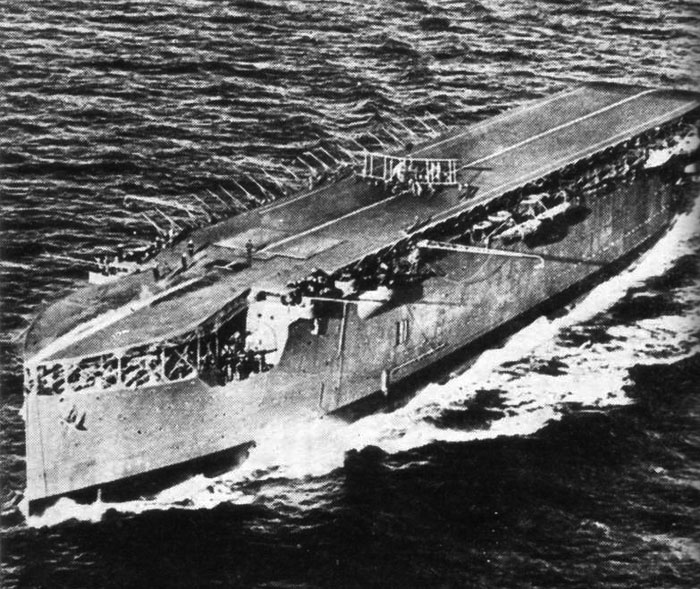
HMS Argus 1922
In September 1922, she received for the first time Gloster Nightjar fighters aboard, and she was sent to the Dardanelles as the Chanak crisis developed (Part of the Turkish War of Independence, it threatened British citizens interest in Turkey). HMS Argus at this occasion taxied and flew off extra Bristol Fighters ferried aboard from the seaplane carrier Ark Royal. They were sent to an airfield at Kilia, European side of the Dardenelles straits. This was the first of her many ferry missions in her lifetime.
In July 1922, and experience was made as she was partially flooded with controlled pumps in order to incline her, and evaluate her stability with all the recent additions on deck and since her conversion. It was discovered that indeed her metacentric height was lwoered by 0.83 feet (0.3 m) and the Director of Naval Construction proposed to to add a girdle at her waterline to make her beamy (and heavier) improving her overall stability.
The 1926 refit
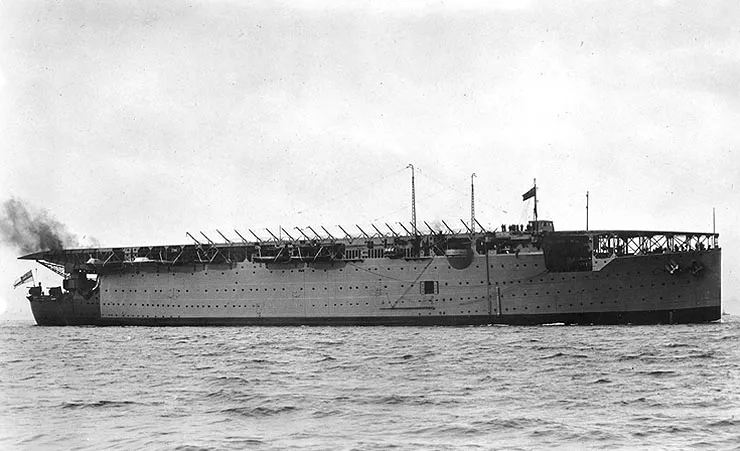
Argus after her 1926 refit
This was planned for the 1923–1924 Naval Programme but delayed several as meanwhile she became the main training carrier of the RN. It was eventually planned, and acted in the 1925–1926 Naval Programme. Girdling also had her rose to 16,750 long tons (17,020 t) with 74 feet (22.6 m) width and draught reduced to the added buoyancy to 22 feet 10 inches (7 m). Top speed was now 19.5 kts. Her old tin can system was abandoned and instead she was fitted with a bulk petrol storage system to refill aircraft. Also, new four-inch guns with fixed ammunition for better rate of fire andd new radio masts were adeed. The latter were lattice structures installed on the port side.
The 1927 overhaul and china station
HMS Argus at the time had a permanent park of 15 aircraft with Fairey Flycatchers fighters, Avro Bison spotter/bombers, and Fairey IIIs for reconnaissance. This was a small yet balanced air group. In 1927 she entered the drydock for a major overhaul in order to ensure another 15 years of service. It was intended also for her to relieve HMS Hermes on the China Station. This was done on 1 September. She stayed at this station until 20 March 1928 and was laid up at Plymouth in limited readiness to save money.
However due to the Washington Naval Treaty clauses about carriers built before its signing, she was automatically reclassified as experimental carrier. Thus she escaped scrapping to save treaty-limited tonnage. She was reduced to Extended Reserve of four months readiness at Rosyth, from September 1932.
The 1936 refit

Argus during a naval parade in the interwar
By February 1936, a refit was needed as the admiralty wanted she test the new Queen Bee target drones as a tender. The latter was a low-cost radio-controlled target aircraft for realistic anti-aircraft (AA) gunnery training based on the very stable and trusted De Havilland Tiger Moth. Ths refit was used to widen her flight deck by 10 feet (3 m), replace her old boilers with brand new, modern destroyer-type boilers generating far more steam in fact that her old turbines could handle. These boilers came from recently scrapped destroyers of the V and W class
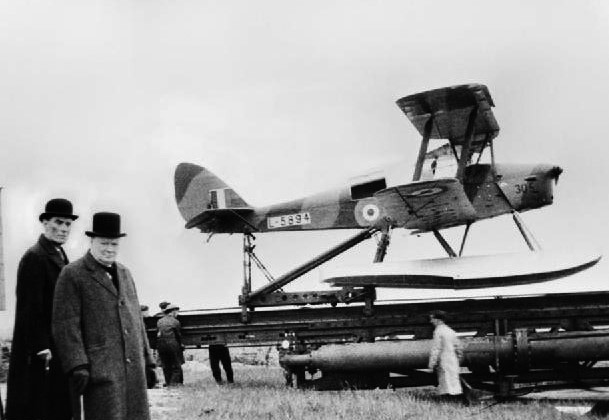
Queen Bee target Drone examined by Winstown Churchill
The great novelty however was to install an hydro-pneumatic aircraft catapult, but at the last moment it sent to HMS Ark Royal. Now a naval auxiliary she was tro be partially disarmed and her 4-inch guns were removed. She left the drydock on 30 July 1938 for sea trials in August, which revealed not issue. She was then classified as Target Aeroplane Carrier, recommissioned on 11 August 1938 with her new captain in command, W. G. Benn.
This role was also combined with that of training carrier. Indeed her short deck made for a good test of pilot’s deck-landing skills. She performed this role with a very small permanent park of Fairey Swordfish when in September 1939 while in the Gulf of Lion news came of the war in Poland.
HMS Argus Wartime carrer
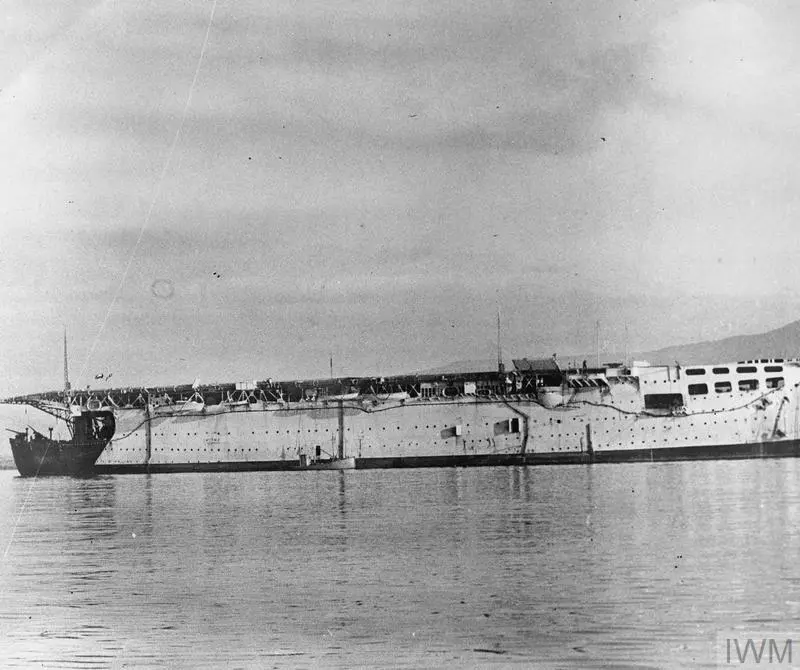
Argus in 1940
Due to the war, the Washington treaty limitation no longer applied and the admiralty could do anything they want with HMS Argus. By April 1940 she was rearmed with two QF Mk V 4-in AA guns on her quarterdeck, reinforced by three quadruple Vickers .50 HMGs. For her first wartime mission, she was to escort HMS Hood and six escorting destroyers, to escort Convoy US-3 carrying ANZAC troops to Britain by mid-June 1940.
As a ferry (1940-42)
A week after, she ferried Supermarine Walrus seaplanes (701 Squadron) to Reykjavík in Iceland. Later she ferried 12 Hawker Hurricane and two Blackburn Skua (418 Flight RAF) in late July. This was the first shipment to Malta (Operation Hurry). She was part of a massive convoy, also comprising HMS Ark Royal, three battleships, two cruisers and 10 destroyers
On 2 August 1940 her impromptu air group flew from a point west of Sicily wiothout incident. Howver two Hurricanes later crashed on landing. She was detached, escorted by the battleship HMS Valiant and two destroyers back to Liverpool, loading on arrival some 30 Hurricanes, with their wings removed to make extra room aboard. She sailed on 22 August, arriving at Takoradi (Gold Coast of Africa) on 5 September. There all the planes were off-loaded to be mounted on arrival after railway transit. Back home, she had a brief refit and was ordered afterwards to carry 701 Squadron in Iceland back home by late October as US troops were about to relievd British forced here (as a reminder, the Island was occupied in fear of a German takeover).
On 11 November, HMS Argus departed Liverpool with 12 flying condition Hurricanes aboard and two Skuas bound to Malta, which was Operation White. She met Force H on the 15th, and launched her planes on 17 November. Sadly, Eight Hurricanes ran out of fuel en route as they tried to punch through strong headwinds. In addition, one Skua was forced to crash land on Sicily after damaged by the Italian flak.
By mid-December, Argus carried a park of six Fairey Swordfish of 821X Squadron destined to Gibraltar and plus two (825 Squadron) for self-defence. She met underway with HMS Furious to protect the Convoy WS-5A. They were spotted underway on 25 December by the German cruiser Admiral Hipper but she was driven off accomplishing little. Unfortunately the RN had an occasion to sink her, but could not, since torpedoes from the Swordfishes aboard Argus were stored on Furious. There were bombs aboard Argus but they were not compatible with her Swordsfish. Nevertheless, Furious launched its Blackburn Skuas while space was cleared on Argus for her Swordfish to load torpedoes aboard. They never took off as the Skuas failed to locate KMS Hipper in poor visibility. Argus was back home on 14 January 1941.
In March 1941, she embarked 12 Hurricane IIs,three Skuas for another supply run to Gibraltar on 29 March, loaded onto HMS Ark Royal, which herself would deliver them to Malta a few days later. Back home on 11 April she received six new Swordfish for her previous Sqn. and six more from 812 Squadron, for self-defence, having a short refit in betwee. On 14 April she departed for Gibraltar carrying replacement planes for HMS Ark Royal.
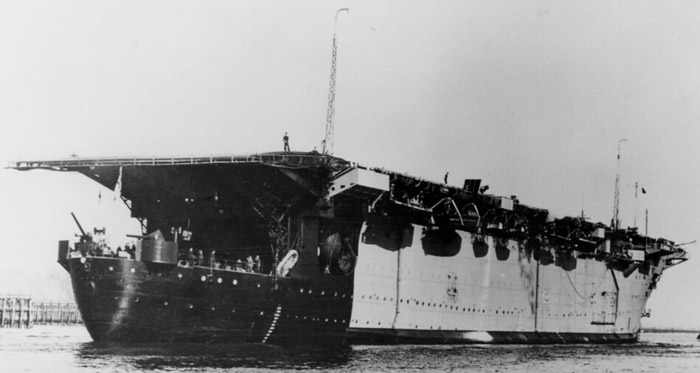
Stern view
On 24 April she delivered her planes and started a two-week refit in Gibraltar. Back home, she loaded 12 Hurricanes again for Gibraltar plus three Fulmars (800X Squadron) for her own protection aganst possible attacks from Fw 200 Condors patrolled the Bay of Biscay and Eastern Atlantic. She arrived and proceeded to the transfer on the 31 May. Back home she was under refit. In August-September she ferried another 24 Hurricanes (151 Wing RAF), this time on the readful northern route, to Murmansk.
Next she returned to Gibraltar, this time with 12 Fairey Albacore (828 Squadron) aboard, arriving on 30 September. These were later dispatched to Malta. For her return home she loaded some damaged aircraft and teamed with HMS Eagle back home, arriving on 20 October. She loaded Hurricanes for Gibraltar plus two Swordfish (818 Squadron) and two Sea Hurricanes (804X Squadron) for her own defensive park. She arrived on 8 November, transferred some Hurricanes to Ark Royal in replacement and joined in Operation Perpetual west of Sicily to reonforced Malta, flying off 37 Hurricanes with Ark Royal. Three were lost en route. HMS Ark Royal was torpedoed while back to Gibraltar, so Argus remained with Force H in replacement.
Force H eventually returned home in January, Argus loading 12 Swordfish (812 Squadron) as her own defensive park. She was now reinstated as active frontline aircraft carrier. She loaded some Supermarine Spitfires bound to Gibraltar, arriving on 24 February. After transferring these to HMS Eagle, she embarked nine Fairey Fulmar fighters (807 Sqn) to take part in Operation Spotter I, where she had to provide fighter cover for HMS Eagle while delivering her Spitfires to Malta.
The whole operation was cancelled: The spitfire’s long-range fuel tanks were defective, but this was resolved on 7 March, and all 15 flew off and arrived later at Malta. Argus would also take part in Operation Picket I: Eagle delivered nine Spitfires on 21 March and she was protected by the 12 Sea Hurricane IIBs from 804 Squadron aboard HMS Argus. The same operation was repeated on 29 March, with the deklivery of the 807 Squadron. Argus this time also carried six Albacores for Malta as well, but they never took off due to appealing weather.
Next, Operation LB was the repeat of the previous operation, Eagle and Argus rearming, the first as taxi and the second providing air defence again but with 12 Fulmars from 807 Squadron. Eagle delivered 3 Albacores and 17 Spitfires on 19 May. The Albacores troubelsime engines had them returning to the carrier. It was disovered that their air coolers were set to “Winter” condition. Later on Fulmar was shot down by a Vichy French Dewoitine D.520 fighters while escorting a Consolidated PBY Catalina flying boat shot down earlier.
Back to UK, Argus was loaded with the 801 Squadron, again bound to Gibraltar, arriving on 7 June. With Eagle she stayed with Force H, covering another imprtant convoy to Malta: Operation Harpoon. She carried for self-defence two Fulmars (807 Squadron), but also nine Swordfish (813 Sqn), four more from 824 Sqn. She was tasked to procedt the convoy from Italian submarines, Eagle (carrying 20 Fulmars and Sea Hurricanes) for air protection.
Dueing the opeation a Swordfish crash-landed on 13 June. Two Fulmars (807 Sqn) were shot down on 14 June by Italian bombers, claiming on SM.79 and one CANT Z.1007. They were transferred to Argus during the long battle, two more being lost. Argus was attacked several times but remained unscaved.
Operation Torch
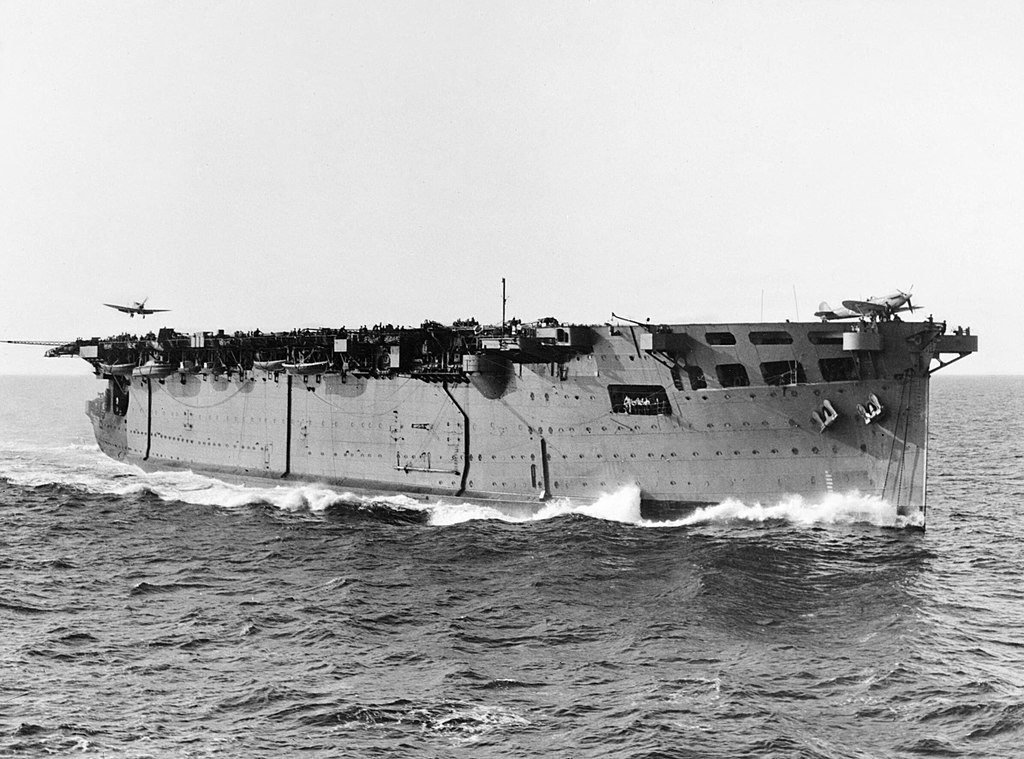
HMS Argus during Operation Toch, taxiing apparently spitfires (she could not have seafires at the time). Note her aft stern black painted section is still there.
One of the most famous assignation of Argus as a frontline carrier was at Operation Toech, the allied landing in Vichy French-controlled North Africa. Before it happened, she was prepared to take part in another massively protected Convoy to Malta, Operation Pedestal, in late June, loading six Sea Hurricanes (804 Sqn), leaving the Clyde on 2 August for her first leg to Gibraltar. She met with other carriers on 5 August for co-ordination procedures exercise. As it happened the 804 Squadron being not ready HMS Argus was ordered back home and she missed the convoy (and battle).
In November 1942, instead she was reassigned to the Eastern Naval Task Force, the British commponent of the allied naval task force. Her objective was Algiers, and for this she was given a full squadron force of 18 brand new Supermarine Seafire IICs (880 Squadron). Operations went on until she was hit by a Vichy French bomb on 10 November, killing four. With HMS Avenger she joined a convoyback home when spotted underway on 14/15 November and abushed by U-Boats.
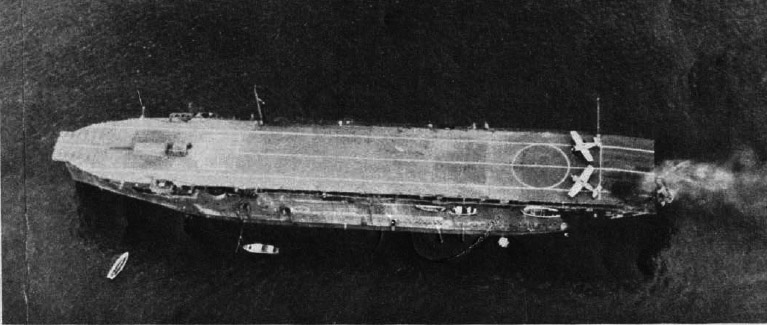
Martlet of HMS Argus’s permanent CAP on the aft deck, circa 1943
U-155 torpedoed HMS Avenger behind Argus in the line but herself was unscaved. Upon arrival, the carrier enderwent an overhaul period for a month and her refit lasted untim May 1943. From there, she was reclassified as an escort carrier but mostly concentrated in deck-landing training and apparently never took on escort roles for the remainder of the year. On 27 January 1944 it was decided to desicarded her, but this was revoked. She was retained for training until 27 September 1944. That day a Fairey Swordfish was the last to take off from her deck.
In March 1944 there was a plan to convert her as an aircraft freighter but this was cancelled. Instead she was reduced to an accommodation ship at Chatham with a skeleton crew by December/ The war ended and she went on in that role until the admiralty decided it was time for her to be scrapped, on 6 May 1946. Sold to Thos. W. Ward on 5 December she was BU at Inverkeithing.

Argus 1944



 Latest Facebook Entry -
Latest Facebook Entry -  X(Tweeter) Naval Encyclopedia's deck archive
X(Tweeter) Naval Encyclopedia's deck archive Instagram (@navalencyc)
Instagram (@navalencyc)





 French Navy
French Navy Royal Navy
Royal Navy Russian Navy
Russian Navy Armada Espanola
Armada Espanola Austrian Navy
Austrian Navy K.u.K. Kriegsmarine
K.u.K. Kriegsmarine Dansk Marine
Dansk Marine Nautiko Hellenon
Nautiko Hellenon Koninklije Marine 1870
Koninklije Marine 1870 Marinha do Brasil
Marinha do Brasil Osmanlı Donanması
Osmanlı Donanması Marina Do Peru
Marina Do Peru Marinha do Portugal
Marinha do Portugal Regia Marina 1870
Regia Marina 1870 Nihhon Kaigun 1870
Nihhon Kaigun 1870 Preußische Marine 1870
Preußische Marine 1870 Russkiy Flot 1870
Russkiy Flot 1870 Svenska marinen
Svenska marinen Søværnet
Søværnet Union Navy
Union Navy Confederate Navy
Confederate Navy Armada de Argentina
Armada de Argentina Imperial Chinese Navy
Imperial Chinese Navy Marinha do Portugal
Marinha do Portugal Mexico
Mexico Kaiserliche Marine
Kaiserliche Marine 1898 US Navy
1898 US Navy Sovietskiy Flot
Sovietskiy Flot Royal Canadian Navy
Royal Canadian Navy Royal Australian Navy
Royal Australian Navy RNZN Fleet
RNZN Fleet Chinese Navy 1937
Chinese Navy 1937 Kriegsmarine
Kriegsmarine Chilean Navy
Chilean Navy Danish Navy
Danish Navy Finnish Navy
Finnish Navy Hellenic Navy
Hellenic Navy Polish Navy
Polish Navy Romanian Navy
Romanian Navy Turkish Navy
Turkish Navy Royal Yugoslav Navy
Royal Yugoslav Navy Royal Thai Navy
Royal Thai Navy Minor Navies
Minor Navies Albania
Albania Austria
Austria Belgium
Belgium Columbia
Columbia Costa Rica
Costa Rica Cuba
Cuba Czechoslovakia
Czechoslovakia Dominican Republic
Dominican Republic Haiti
Haiti Hungary
Hungary Honduras
Honduras Estonia
Estonia Iceland
Iceland Eire
Eire Equador
Equador Iran
Iran Iraq
Iraq Latvia
Latvia Liberia
Liberia Lithuania
Lithuania Mandchukuo
Mandchukuo Morocco
Morocco Nicaragua
Nicaragua Persia
Persia San Salvador
San Salvador Sarawak
Sarawak Uruguay
Uruguay Venezuela
Venezuela Zanzibar
Zanzibar Warsaw Pact Navies
Warsaw Pact Navies Bulgaria
Bulgaria Hungary
Hungary

 Bundesmarine
Bundesmarine Dutch Navy
Dutch Navy Hellenic Navy
Hellenic Navy Marina Militare
Marina Militare Yugoslav Navy
Yugoslav Navy Chinese Navy
Chinese Navy Indian Navy
Indian Navy Indonesian Navy
Indonesian Navy JMSDF
JMSDF North Korean Navy
North Korean Navy Pakistani Navy
Pakistani Navy Philippines Navy
Philippines Navy ROKN
ROKN Rep. of Singapore Navy
Rep. of Singapore Navy Taiwanese Navy
Taiwanese Navy IDF Navy
IDF Navy Saudi Navy
Saudi Navy Royal New Zealand Navy
Royal New Zealand Navy Egyptian Navy
Egyptian Navy South African Navy
South African Navy






























 Ukrainian Navy
Ukrainian Navy dbodesign
dbodesign